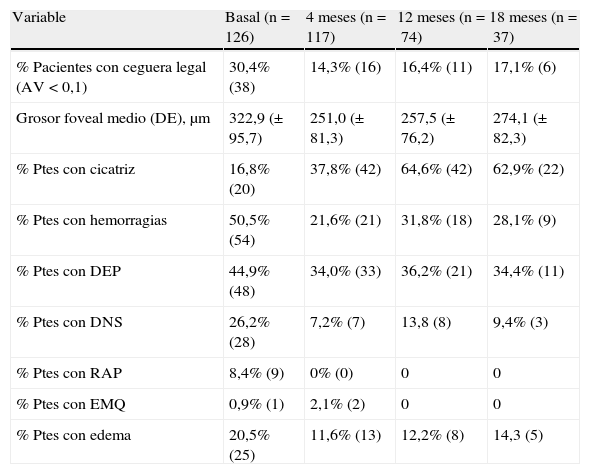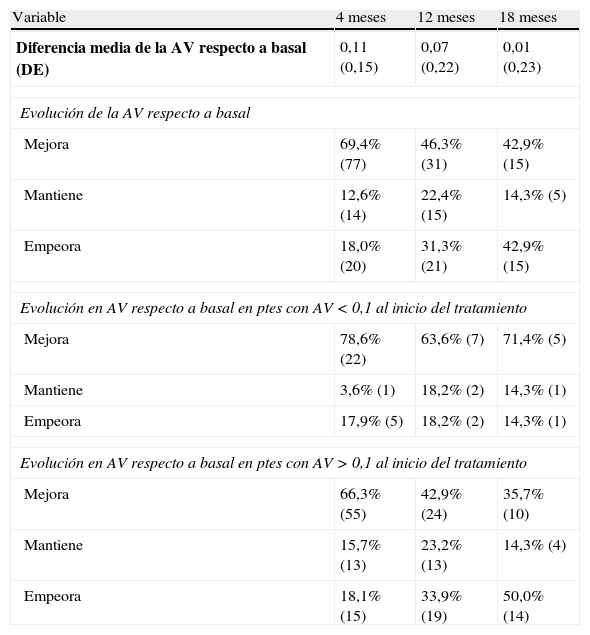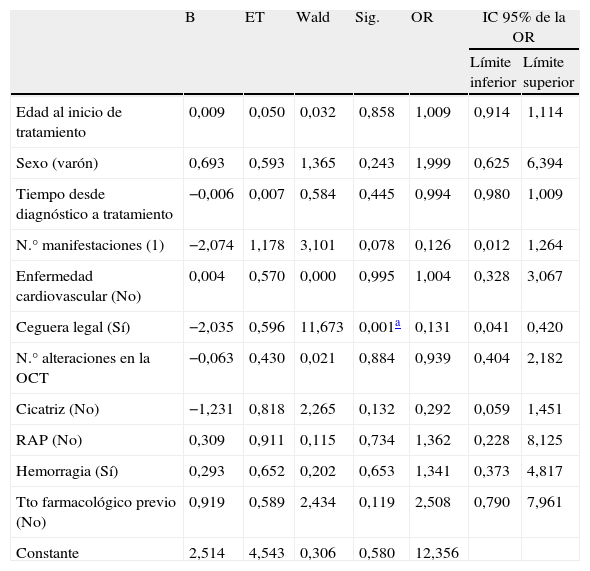La degeneración macular asociada a la edad (DMAE) neovascular es una enfermedad degenerativa y crónica. Los tratamientos actuales sólo han demostrado ralentizar la progresión de la DMAE. El objetivo del estudio es evaluar la efectividad y seguridad de ranibizumab en una serie de pacientes, así como describir sus características demográficas y clínicas.
Pacientes y métodoSe realizó un estudio observacional y retrospectivo, incluyendo todos los pacientes que iniciaron tratamiento desde el 1-12-2006 hasta el 31-12-2008, realizándose el seguimiento hasta el 31-03-2009. Se realizó un análisis bivariante y modelos de regresión logística para analizar la influencia de factores demográficos y clínicos en la efectividad y en la durabilidad del tratamiento. Se recogieron las reacciones adversas descritas en las historias clínicas para evaluar la seguridad.
ResultadosSe incluyeron 112 pacientes con una media (DE) de edad de 77,7 (6,0) años. La media de durabilidad del tratamiento fue de 18,2 meses, siendo superior en el grupo de pacientes que iniciaron tratamiento con agudeza visual (AV) > 0,1 (p<0,001). Ranibizumab mantenía la AV por encima de los valores basales hasta los 18 meses. Ninguna de las variables estudiadas se asoció con la efectividad del tratamiento. La agudeza visual inicial influía en la duración del tratamiento, siendo superior en el grupo de pacientes con AV > 0,1.
ConclusionesRanibizumab parece ser efectivo hasta los 18 meses. Un diagnóstico precoz de DMAE permitiría un inicio del tratamiento más temprano cuando los pacientes presentan valores superiores de AV, optimizando los beneficios del tratamiento. Ranibizumab fue bien tolerado y seguro en la mayoría de los pacientes.
Neovascular Age Related Macular Degeneration (ARMD) is a chronic and degenerative disease. Current treatment options are limited and have shown to slow disease progression. The aim of this study was to assess Ranibizumab effectiveness and safety and to describe patients’ demographic and clinical characteristics.
Patients and methodWe conducted a retrospective observational study including all patients who had started treatment between 1/12/2006 and 31/12/2008, and were followed up until 31/03/2009. A bivariate analysis on months 4, 12 and 18 and two logistic regression models were performed to analyze the influence of demographic and clinical factors on the effectiveness and durability of treatment. Adverse reactions were collected as described in the medical records to assess safety.
ResultsA total of 126 eyes of 112 patients were recruited. The mean age was 77.7 (± 6.0) years. The mean durability of treatment was 18.2 months, and it was higher in the group of patients who started treatment with visual acuity (VA) > 0.1 (p<0.001). Ranibizumab therapy maintained AV over baseline at 18 months. None of the studied variables showed any influence on treatment effectiveness. However, baseline visual acuity influenced on treatment duration, being higher in the group of patients with AV > 0.1.
ConclusionsRanibizumab was shown to be effective until 18 months. Early diagnosis of AMD could lead to an earlier treatment start, when patients present a higher AV, in order to optimize the benefits of treatment. Ranibizumab was well tolerated and safe in most patients.
Artículo
Comprando el artículo el PDF del mismo podrá ser descargado
Precio 19,34 €
Comprar ahora












